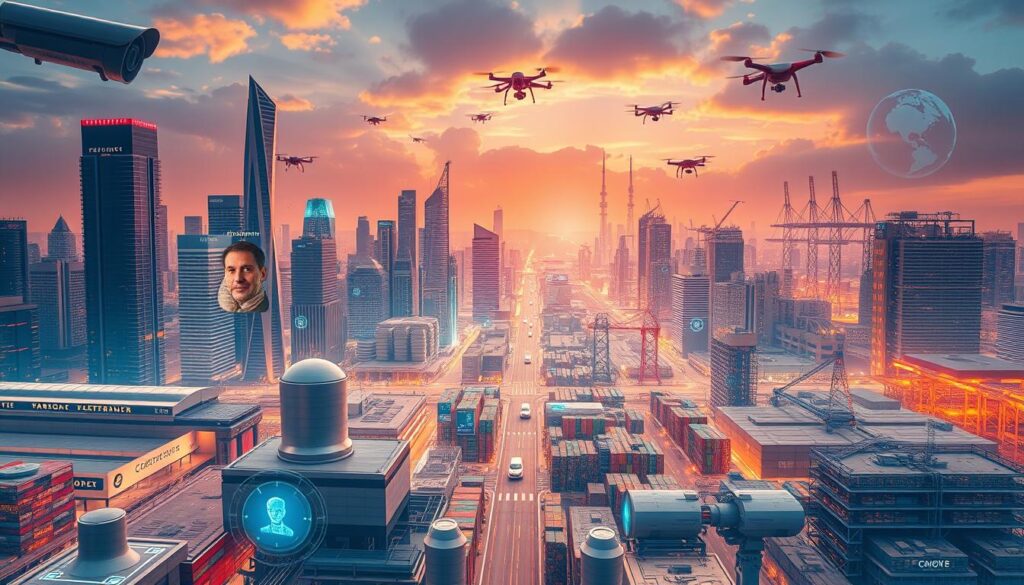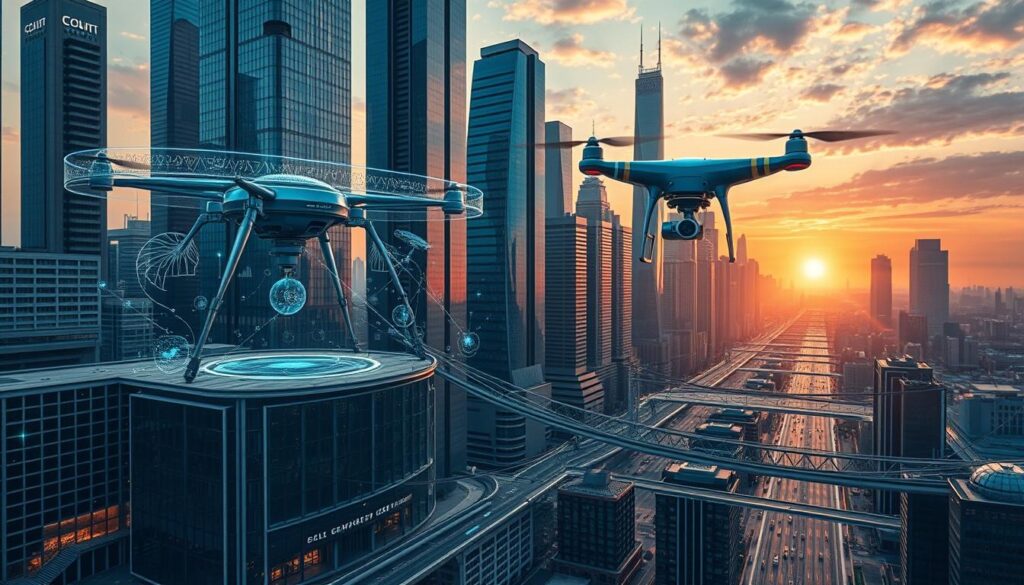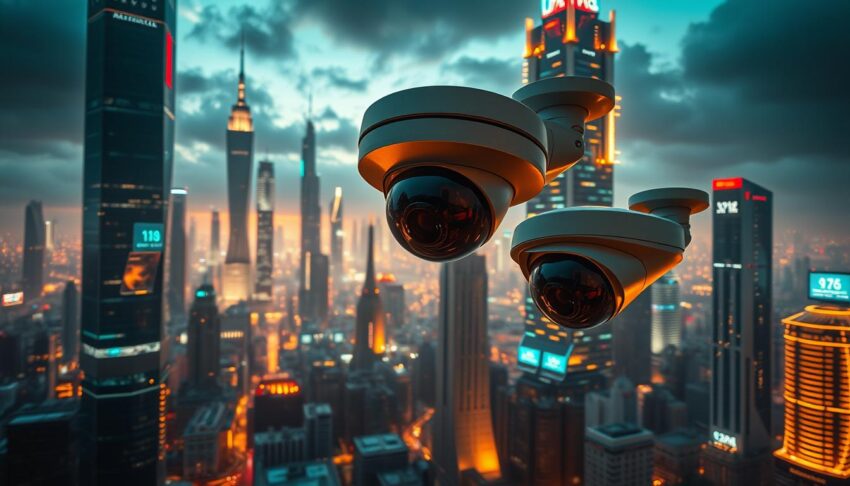Have you ever thought about how machines can see like us? This question is at the core of computer vision. It's a field that's changing how we use technology.
Computer vision helps us understand visual data. This is key in our world that loves pictures and videos. It's used in healthcare, retail, and cars, opening up new chances for growth and creativity.
Let's dive into this exciting area. It connects data to useful insights.
Key Takeaways
- Understanding computer vision is essential in modern technology.
- It plays a crucial role in developing artificial intelligence applications.
- Various industries leverage insights from computer vision for innovation.
- Key advancements include machine learning and image recognition.
- Future trends promise substantial growth in real-world applications.
Introduction to Computer Vision
Computer Vision lets computers understand pictures and videos. It uses special methods to do this. These methods help computers see like we do.
It's all about making computers smart about what they see. They can learn from images and videos. This way, they can understand things better.
Computer Vision uses many techniques. It starts with processing images. Then, it finds important features and recognizes patterns.
These steps help computers make sense of what they see. This field has grown a lot over the years. Now, it helps in many areas like healthcare and cars.
Computer Vision has come a long way. It started simple and has grown a lot. Now, it's used in things like surveillance and virtual reality.
Key Components of Computer Vision Technology
Computer vision technology has many important parts. It uses machine learning and deep learning. These help systems understand pictures very well.
Machine Learning in Computer Vision
Machine learning is key to computer vision. It lets systems learn from pictures. They get better over time by finding patterns.
They use lots of pictures to learn. This way, they can spot objects and do tasks. They understand pictures very well.
Deep Learning Algorithms
Deep learning is a part of machine learning. It uses special networks to look at pictures. These networks find complex patterns.
This makes computer vision work better. For example, it helps cars drive by themselves. It also makes facial recognition very accurate.
| Component | Description | Use Cases |
|---|---|---|
| Machine Learning | Algorithms that learn from data for predictive tasks. | Image classification, object detection, and activity recognition. |
| Deep Learning | Neural networks that analyze complex patterns in images. | Facial recognition, self-driving cars, and advanced medical imaging. |
These parts of computer vision lead to new ideas. They make it a very important technology today.
Latest Trends in Computer Vision
Computer vision is changing fast. New tech in image recognition and artificial intelligence is leading the way. These changes could make many things better, like how we see and understand pictures.
Advancements in Image Recognition
New image recognition tech is getting better and faster. Machine learning is a big part of this. It helps computers see and sort pictures more accurately.
This means we can use computers in more ways. They can help us on social media, keep us safe, and even in healthcare.
The Role of Artificial Intelligence
Artificial intelligence is key to computer vision's growth. It uses special kinds of computers to learn from lots of pictures. This helps computers get better at recognizing things.
Many industries are using this tech. Cars, stores, and more are getting smarter. They can spot things and work better on their own.
Applications of Computer Vision in Various Industries
Computer Vision changes many industries in big ways. It helps healthcare get better results for patients. It makes shopping online better by knowing what you like. And it makes cars drive better by itself.
Each area shows how computer vision can solve big problems. It makes things better for everyone.
Healthcare Innovations
In healthcare, computer vision is very important. It helps doctors see what's wrong with patients faster. It looks at X-rays and MRIs to find problems early.
This tech helps doctors make quicker choices. It also trains new doctors with real images.
Retail and E-commerce Enhancements
In shopping, computer vision makes things better. It knows what you like and shows you more of it. It also keeps track of what's in stock, so you don't have to wait.
This makes shopping online smoother and more fun.
Automotive Technologies
Computer Vision is key for self-driving cars. Companies like Tesla use cameras to see the road. This makes driving safer and more efficient.

Image Processing Techniques in Computer Vision
Image processing is key in computer vision. It makes visual data better for analysis. Techniques in computer vision use algorithms to change raw images. This makes them easier to understand.
Filtering removes noise and makes images clearer. Edge detection finds big changes in images. This helps models see where objects start and end. Image segmentation breaks an image into parts. This makes it simpler to focus on what's important.
Many industries use image processing to innovate. In healthcare, it makes medical images clearer. This helps doctors make better diagnoses. In cars, it helps with safety features like lane detection. Retail uses it to make shopping better with visual systems.
| Technique | Description | Industry Application |
|---|---|---|
| Filtering | Removes noise and sharpens images for better clarity. | Healthcare (medical imaging) |
| Edge Detection | Identifies and outlines objects within images. | Automotive (safety systems) |
| Image Segmentation | Partitions images into segments for targeted analysis. | Retail (visual merchandising) |
Understanding Object Detection
Object detection lets machines find and spot objects in pictures or videos. It uses special algorithms and methods. This tech is very useful in many ways.
How Object Detection Works
Object detection uses machine learning and deep learning. First, images are made better for analysis. Then, special algorithms like CNNs find patterns.
Boxes are drawn around objects found. Models then say what those objects are. This makes finding things faster and more accurate.
Real-World Applications of Object Detection
Object detection helps in many fields. It keeps places safe by spotting trouble. Robots use it to move and do tasks.
Self-driving cars use it to see and avoid things. Here's a list of where object detection is used:
| Industry | Application | Significance |
|---|---|---|
| Security | Surveillance systems | Increases safety by identifying threats |
| Robotics | Navigation | Facilitates intelligent interaction with environments |
| Automotive | Autonomous driving | Improves road safety and efficiency |
| Retail | Inventory management | Streamlines stock tracking and management |
| Healthcare | Medical imaging | Enhances diagnostics accuracy |
Object detection is key in many areas. As tech gets better, its role will grow. It helps make things more efficient and innovative.
Facial Recognition Technology
Facial recognition technology has changed many areas. It makes security and identifying people better. But, it also brings up big challenges and questions about ethics.
We need to find a way to keep privacy safe. At the same time, we should use the good parts of this technology.
Challenges and Ethical Considerations
Using facial recognition raises big questions about privacy and misuse. These issues include:
- Algorithmic Bias: Facial recognition systems can be unfair to some groups, leading to wrong results.
- Surveillance Practices: Using facial recognition in public can take away our freedom and watch us too much.
- Consent Issues: Taking biometric data without asking can break our privacy rights.
We really need rules and guidelines for this. Talking about facial recognition is not just about the tech. It's also about how it affects us all.
Video Analysis in Computer Vision
Video analysis is key in computer vision. It changes many areas. It makes surveillance better and media more fun.
Surveillance and Security Applications
Video analysis helps watch places better. It uses smart tech to spot odd things fast. This makes places safer, like parks and malls.
Improving User Engagement in Media
It also makes media better by showing what you like. Sites use your watching habits to suggest videos. This makes watching more fun and keeps you coming back.
Visual Analytics in Computer Vision
Visual analytics is key in computer vision. It helps turn raw visual data into useful insights. This mix of advanced computing and data display lets users explore big datasets. It also helps find important information hidden in images and patterns.
Transforming Data into Insights
Turning data into insights involves a few important steps. These steps help us understand visual information better. Here's how:
- Data Acquisition: First, we collect visual data from many sources like cameras and drones.
- Data Processing: Then, we clean and sort the data to get rid of useless stuff.
- Data Visualization: Next, we use special ways to show the data. This makes it easier to see trends and patterns.
- Analytical Interpretation: Finally, experts use tools to look at the data. This leads to insights that help make big decisions.
Visual analytics is used in many ways. In marketing, it helps companies understand how people act. This helps them make better ads. In studying behavior, it helps scientists see how people move and interact. This gives us a better look at social behavior.
Future Projections for Computer Vision
The future of computer vision looks bright. It's thanks to new machine learning tech. These tools will change how machines see and understand pictures.
Systems will get better at doing hard tasks. This will open up new uses in many fields.
Potential Developments in Machine Learning
New breakthroughs in machine learning are coming. They will make computer vision even better. Neural networks will learn to handle tough data.
They will understand pictures better. This means machines can work faster in places like security and healthcare.
They will learn more from data. This will make them smarter and more helpful.
Impact on Daily Life and Work Environments
These tech changes will affect our daily lives a lot. Smart homes will get smarter. They will know what we like and make our lives easier.
At work, computers will help us do things faster. This means we can get more done in less time. Stores will be able to manage their stock better.
Computer vision will soon be a big part of our lives. It will change how we use technology every day.

Conclusion
Computer vision is changing many fields, bringing new ideas and chances for growth. We've seen how it has grown, thanks to better machine learning and AI. These changes are big for healthcare, shopping, cars, and more.
This tech is making things better and smarter. It's changing how we work and make choices. Knowing about these changes is key for the future.
The story of computer vision is still unfolding. It's going to keep making things better and smarter. Those who follow these changes will find great opportunities.
